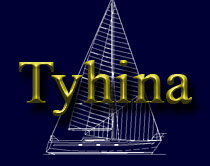

| 18 May 2007 |
Manhattan, NY City Hi everyone, Much has happened since we left Fort Pierce at the end of April… and (maybe as usual!) nothing as planned! But you would probably have guessed that since I’m writing from the Big Apple rather than Canada! |
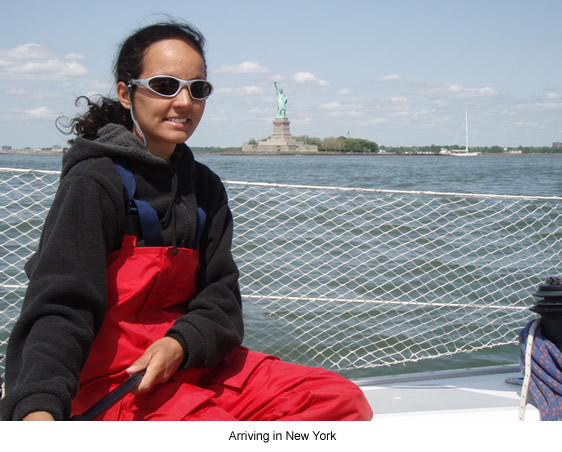 |
We left Fort Pierce with the best weather-window in weeks and felt confident about the journey. But while the coast was still in sight and we were making good progress under sail towards the Gulf Stream, I started feeling sea-sick, like never before. I had to retreat to our cabin for 3 long days and 3 long nights, unable to eat or drink, or even move, while Peter single-handed Tyhina into the Gulf Stream and up North toward Canada, with dolphins as his sole company. After concrete-laden and highway-polluted Florida, Charleston seemed to belong to another country all together, and after I gobbled another bowl of porridge and 4 boiled eggs, we set to experience the Southern hospitality in a pub with a super burger, fries and Coke! In Charleston, we came across Turmoil, also bound for Greenland. They should get there at about the same time as us, but only after visiting France and a few other places along the way (yeah, you read right, I did write France… like in Europe!). Turmoil is a 200ft steel power boat that carries a professional crew and a team of scientists. We went to say hello, but didn’t get invited on board. It’s a pity, it would have been nice to pick their brain… and a few charts! But never mind… |
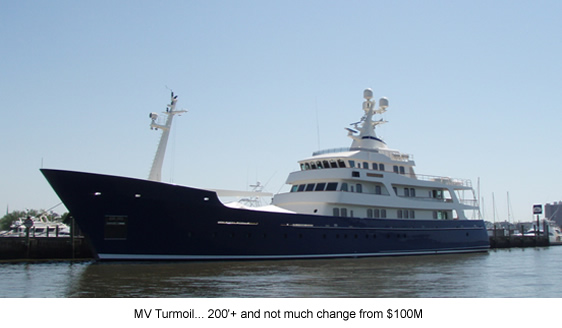 |
After a few lazy days in Charleston, I got myself high on sea-sickness tablets (double dose!) and we set off again. This time, the weather window wasn’t as clear cut as before, but it wasn’t too bad. We were expecting a weak cold front, then another one a little bit stronger a few days later, but nothing major. A low system developing in the Carribean Islands was due to travel towards the Azores, which was good news. And so we left and headed for the Gulf Stream once again, where we were greeted by dolphins and birds. The Bottle Nose dolphins love to play in the wake of the boat and I can never tire of their games. Others travel in huge groups, and can’t care less! One night, we gave asylum to a tinny little bird that didn’t quite seem to belong to the ocean. It circled around us many times, landed on ropes and life lines, circled more and landed more, each time a little closer to where we were seating on the cockpit, and finally went straight inside to rest in the galley. The Gulf Stream was slow and hot, with no wind, but plenty of time for reading, relaxing and our first loaf of fresh bread! Yes indeed, made from scratch with my little fingers and baked in the pressure cooker transformed into a Dutch oven. Not a real sourdough thing, rather a good ol’ damper the Australian way. |
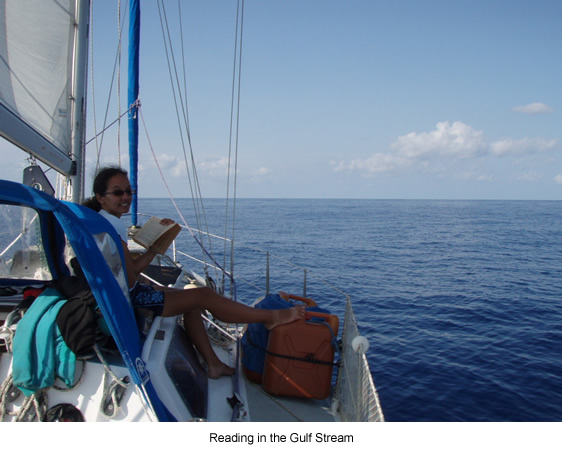 |
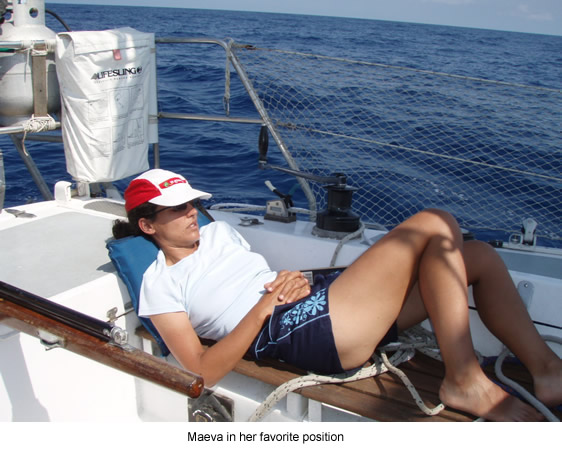 |
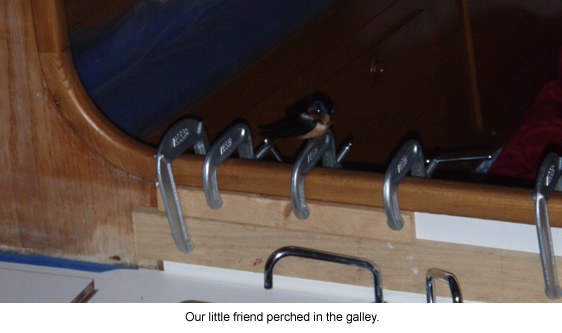 |
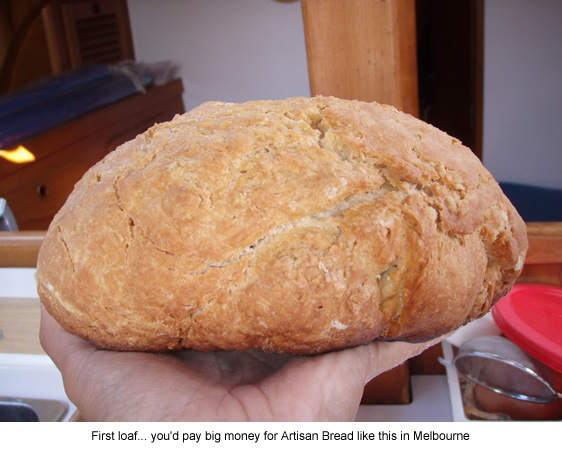 |
That night, while we were marveling at our little bird and freshly made bread, the first cold front blew in. It came very quickly. It started with a few ripples on the surface of the ocean and within a few hours, it had developed into big waves and strong winds. We were expecting 15 to 20 knots with small waves, we got 25 knots with 6 to 10 ft waves. So much for a weak front… what was the next going to be like?! When Peter had checked the weather forecast just a few hours before, he had somehow questioned the forecast path of the low system from the Carribean Islands. And what if, he thought, the little bugger decided to head North rather than East? With storms and lows at sea, it’s always the same dilemma. Do you get closer to shore, hoping to be somehow sheltered but with the risk of running out of water if you need to escape? Or do you head for the big wide open, with less shelter but plenty of water in front of you to run away? As the supposedly weak front got stronger, we decided to get back closer to shore. Twenty-four hours later, we heard the warning: the low system had changed its mind and was heading North… and it was angry! And guess what… we were on its path! So once again we were bound to land. Peter picked Beaufort, North Carolina. It didn’t seem too far on the chart, but with strong head winds and waves, it took us more than 24 hours to get there, that’s a long day and an even longer night not making much progress. Along the way, in our full foul-weather gear and harness on our little Tyhina (funny how he seems smaller in those conditions!), we were nearly run over by a much bigger sailing yacht, heading for port full steam with no one on watch (they were probably watching some TV downstairs!). Then, we spotted a large power boat that wasn’t making any progress. We could see it bobbing up and down in what would have been a killer for me even with triple dose of sea-sickness tablets. And as we sailed past, we saw at least a hundred of weekend fishermen each with his little fishing line and about a quarter of a square meter… It’s called a fishing charter tour and some people even pay for that! We reached Beaufort the day before the storm really hit. Even safely moored at the marina, it looked bad. We saw the boat that had nearly run over us and many others that, like us, came to take shelter. But others were not so lucky. As winds reached gale force with 30-ft waves near the Gulf Stream, the US Coast Guards (not Kevin Costner… the real guys!) were called many times. They rescued three sailors in their life raft after they abandoned ship. The whereabouts of another yacht, 54-ft Flying Colors, were still unknown a week after they switched their EPIRB on. The storm brought one good news to us: we were granted a new US Cruising Licence. This enabled us to keep heading North via the Atlantic Intra-Coastal Waterway while strong winds still prevailed outside. It is a little known fact outside of the USA that one can travel on water from the Canadian Great Lakes all the way to Florida nearly without having to head out to the ocean, through a series of man-made canals and locks connecting lakes, rivers and sheltered sounds. The Waterways, many of which started as private ventures, are now maintained by the United States Army Corps of Engineers and used both by pleasure boaters and commercial shippers. |
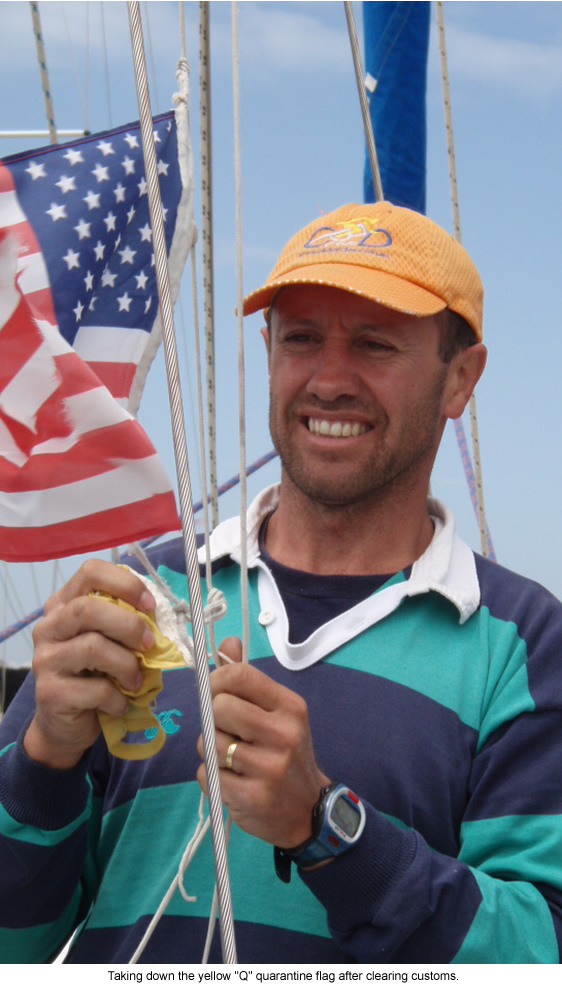 |
From Beaufort, we traveled along Adams Creek Canal, crossed the Neuse River, continued along the Alligator River into Albermarle Sound to Elizabeth City, then opted for the Dismal Swamp Canal, the oldest operating artificial waterway in the US, that took us to Norfolk and Hampton in Virginia. The story of those waterways dates back more than 200 years. Shortly after the Revolutionary War, the new nation desperately needed good roads connecting one end of the country to the other. If the country was to grow and prosper, an effective system of internal transportation had to be developed. At first, taking the waterway seemed to us like just a way to make some progress while the weather prevented us from going offshore. It was a means to an end. But we were soon caught by the magic of the place. Waking up in an eerie fog, traveling from one channel mark to another as it lifted, watching birds balancing their nest on top of moving buoys, waving to the many crab fishermen speeding from one crab pot to another, traveling along canals so narrow the rigging would hit trees as soon as we’d get off course, we got a sense of how the Southerners can be so in love with their very flat and very swampy land. |
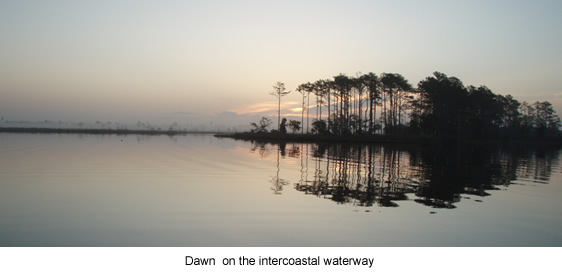 |
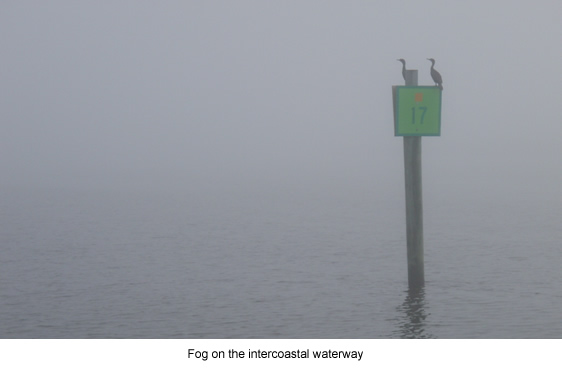 |
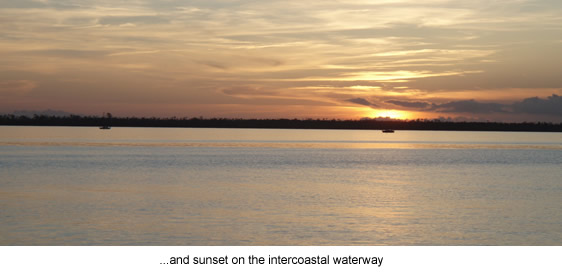 |
|
For a while, we traveled with a group of French Canadians, on board Nuage Bleu and Le Manitou, who were full of stories about Alaska and British Columbia, shared some of their wisdom with us, and were very good company. We parted at the Deep Creek Lock, where they decided to stay for the night while we continued onto Norfolk. |
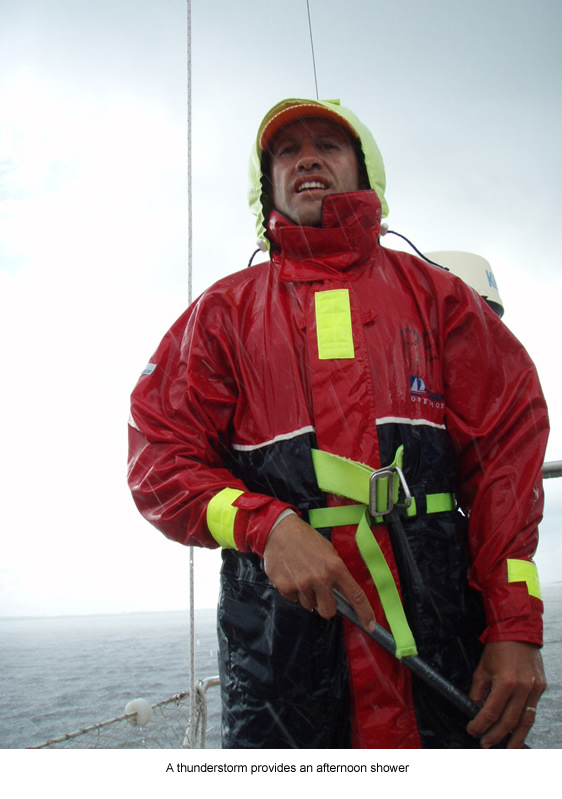 |
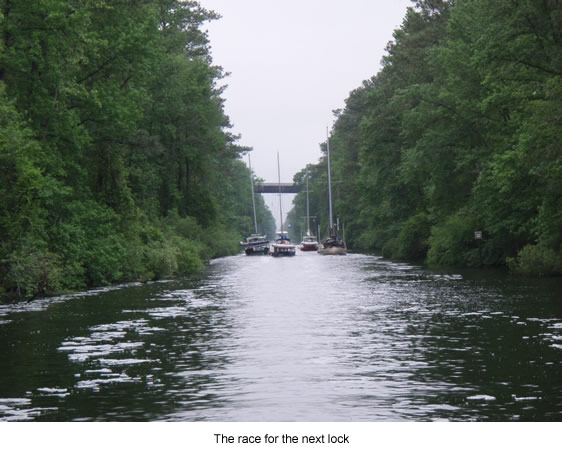 |
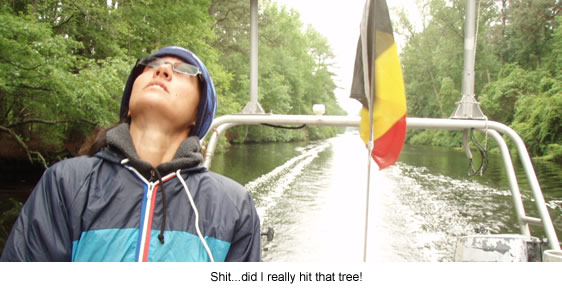 |
There wouldn’t be much to say about Norfolk except that we had again an amazing ride, but this time for a very different reason. Gone were the foggy swamps and dense forests, replaced by rows of aircraft carriers and submarines! Norfolk is apparently a large US Navy base, and it’s not hard to believe considering that in a few hours we saw more war planes and grey-painted ships than we would if we were to tour all over Australia! Needless to say Peter got very excited and I had to steer while he went hard on the camera! |
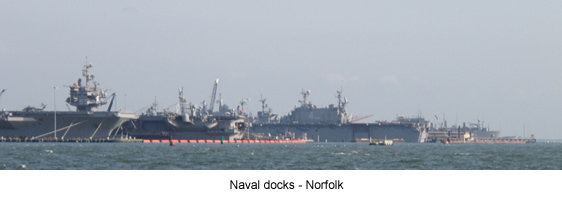 |
We didn’t stop in Norfolk, preferring to anchor in nearby Hampton. Well protected anchorage (always a good thing), $1 shower (that’s important after 5 days in the wild!), a laundry easily reached by dinghy (providing some local dude doesn’t send you in the opposite direction), a space center with more aircraft (that’s for him) and free WiFi connection throughout town (that’s for her)! The highlight (except for the very long and very warm shower) was being stopped by a policeman for excessive wake while we were dinghy-ing back from the laundry… with a heavy metal flat-bottom dingy and a 2HP engine… what a cracker! |
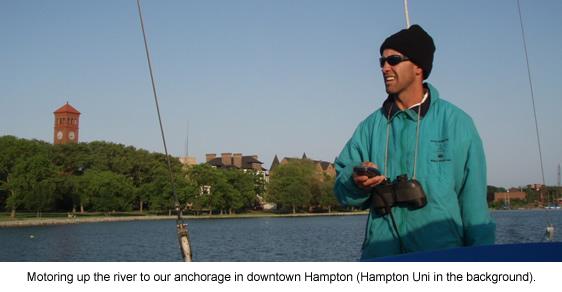 |
Finally from Hampton, we headed back to the ocean and set our bearing to New York. We are glad to be able to report that for the first time, we did indeed reach the destination we had planned! For once, I was well prepared: double-dose on sea-sickness medication coupled with pressure-point wrist bands (that left me two red spots on my wrists) supposedly used in hospitals to relieve nausea symptoms in cancer patients and supposedly equally useful against motion sickness. And for a change, the weather forecast was right: it had announced 20- to 25-knot SW winds and we got just that. For the record, we also got some 10-ft waves right from behind, which is never very comfortable. If you’ve got no idea what a 10-ft wave can look like on board Tyhina, try imagine making yourself a nice cuppa in your kitchen and looking outside through the back door, and you can just see the tip of a wave over your man-size backyard fence! |
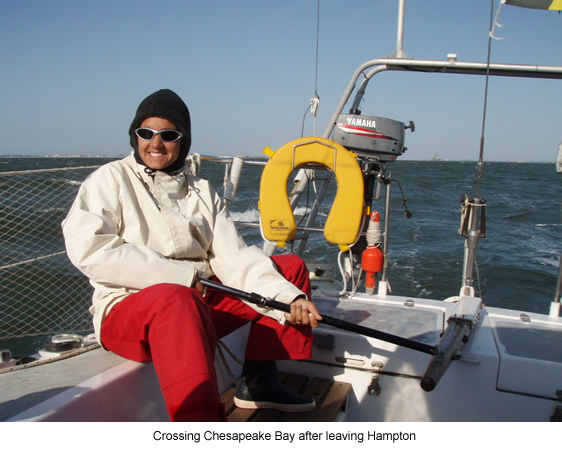 |
So here we are in New York! |
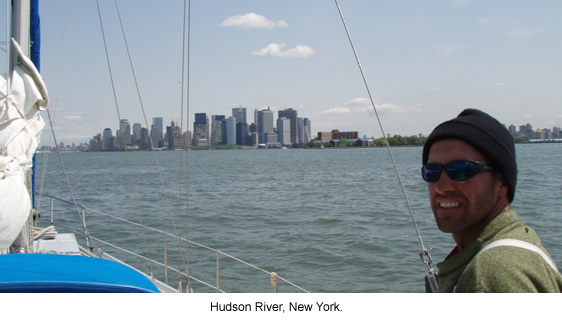 |
| 23 April 2007 |
It’s been about a week since our last posting but it feels much longer with so much happening as we slowly adjust to living onboard in the water rather than working onboard in a shipyard! |
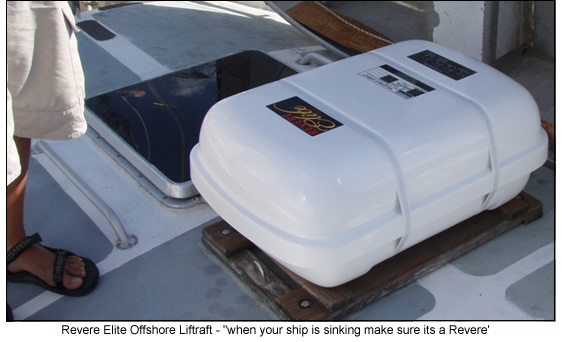 |
The second bad news came from when we tried to register under our name the various onboard communication equipment such as HF radio, VHF radio, etc. Since the boat was previously registered and is still registered in Belgium, that seemed like an easy task. I’ll spare you the details but it came down to: the gear can’t be registered in Belgium because the particular brands and models we have on board are US-compliant, not European-compliant!!! Yes, you’re right, it means the previous owner got his registration under false information!!! But again, we were lucky to find a no-nonsense person at the Belgian registration office who issued the license on the basis that we are very unlikely to make it to Europe (and if we ever do, we’ll get a new European-compliant VHF then). In between all that, we managed to transfer 1-month worth of food supplies and groceries from a bobbing dinghy to Tyhina without dropping anything in the water (that took a little bit of balancing!), enjoy a few sunny breakfasts on our 360-water views deck (with dolphins swimming around!), and catch-up with friends and family on the net. Here’s what it looks like from our end: |
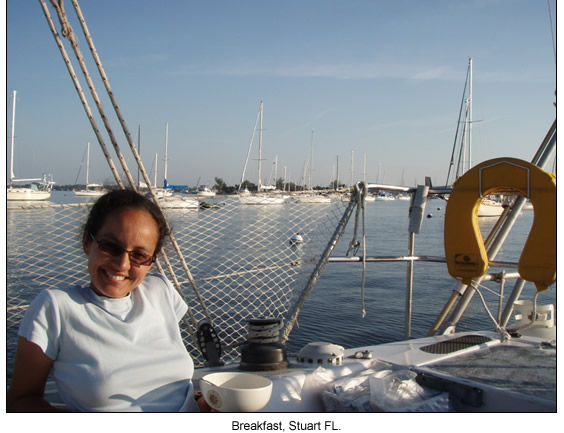 |
On Sunday, we motored down the St Lucie canal to Fort Pierce. We passed under many bridges and got passed by massive power boats Florida style, but no alligator and no manatee (the local ‘dugong’). We booked ourselves into a marina (American size!) so that we could receive our new life raft and get a good night sleep before leaving US waters. We have some companions under the hull, little shrimps that seem to be having a ball banging their head into our brand new anti-fouling paint! It is now Monday night and tomorrow we are heading out… the ocean! Talk to you soon! Maeva |
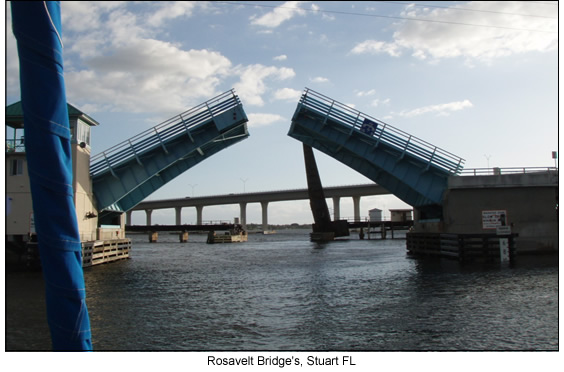 |
| 15 April 2007 |
Tyhina went back in the water on Tuesday 10th April, after 9 months in dry storage and a 3-month refit that included the normal maintenance such as bottom paint and hull polishing, as well as new electrical system, new insulation, galley refurbishment. Spending 3 months in a work yard was a necessity, but although it may not sound glamourous, it was quite rewarding to see the transformation of Tyhina. |
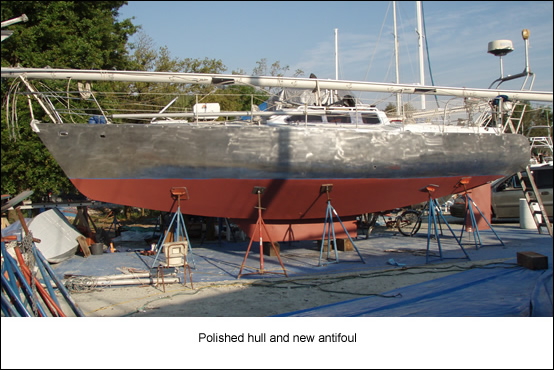 |
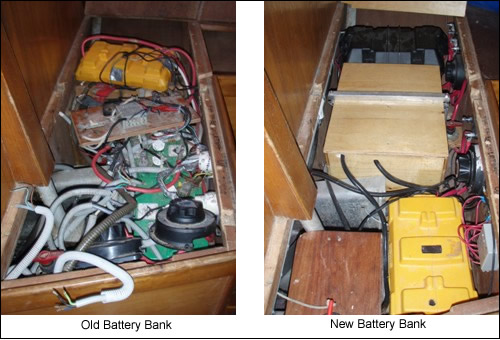 |
The heat, the dust, the challenge of refitting a 'metric' boat in an 'imperial' country, the sore back after a day of sanding or bolting some equipment in an awkward spot (and believe me, there's a lot of them on a boat!) made our daily routine for 3 months. Then, late at night, we would pack our shower bag, dinner bag and laptop bag, and head off to the marina's headquarters for a long shower, a brief dinner and some time chasing spare parts on the Internet. We left Indiantown Marina in the afternoon of Thursday 12th April to spend our first night at anchor in the St Lucie canal just outside the marina with two Canadian boats. With Pete at the helm, I was in charge of foredeck operations, ie. 'anchor girl'. In my haste, I let go of too much chain too quickly which I then had to take back all by hand on the manual windlass! Once the anchor was in place, I rowed in the dinghy to secure an aft anchor on the northern bank of the canal. And so we spent the night. |
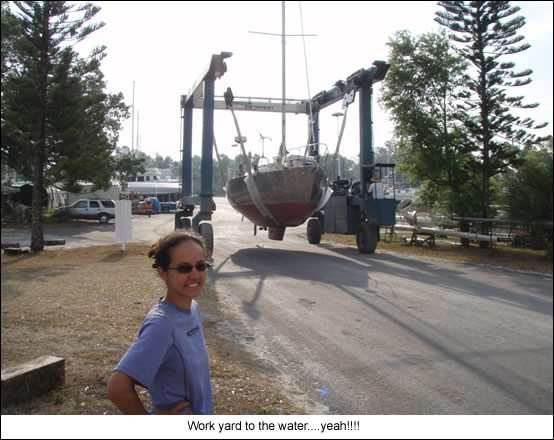 |
Early Friday morning, we began motoring down the St Lucie canal to Stuart, passing under several bridges and through the St Lucie lock, which I found quite interesting until the lockmaster opened the massive doors just a few meters ahead of where I was standing at the bow and I looked at the drop between the water level inside the lock and the canal ahead of us. But that was routine and we smoothly came down the 3m fall as the water levels adjusted inside and outisde the lock. We reached Stuart around 4pm the same day after passing many mansions and private jetties, and much more interestingly some local birds and a few alligators. We are now anchored in Stuart, more precisely Pendarvis Cove on the St Lucie river, where we will further ready Tyhina for the 3- to 4-week passage to Halifax, Canada. Tools, spare parts must be properly stowed away, as must all the knicks and knacks a sailboat carries. The first part of this preparation took place in Indiantown and drew the attention of many marina residents wondering how we would manage to fit everything in! Later this week will come food as well as a new EPIRB and life raft. Maeva |
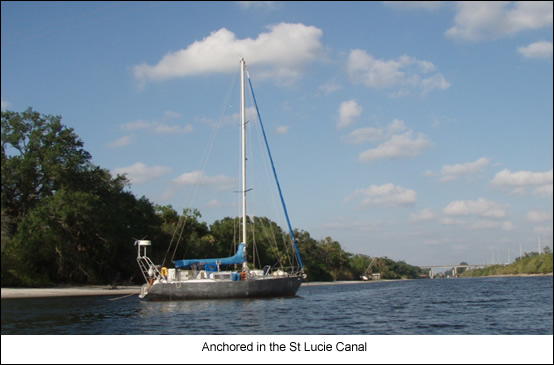 |
| 18 December 2006 |
Tyhina is currently on the hardstand at Indiantown Marina, Florida waiting to be moved into the work area for gear updates and maintenance. The major items that Tyhina will be getting include a new coat of antifoul, new electrical wiring through out, increased insulation for the arctic, new standing rigging, new life raft and upgraded ground tackle for the deep water anchorages in the Newfoundland, Labrador and Greenland. Indiantown is situated on the St Lucie canal which runs from Stuart on the Atlantic coast through Lake Okeechobee to Fort Myers on the Gulf of Mexico coast. |